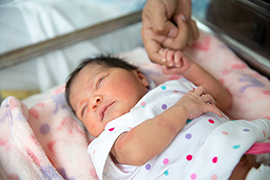- Slug: BC-CNS-Baby Bounce740
- Photo, graphic available (embed code, thumbnail, caption below)
By Neetish Basnet
Cronkite News
WASHINGTON – The number of children born in Arizona last year rose for the first time in seven years, stumping experts who had expected a baby bust to worsen through the pandemic.
But Arizona Department of Health Services data shows that 77,735 children were born in the state last year, a 1.2% increase from the 76,781 born a year earlier, reversing six years of steady declines.
Experts are not sure what’s behind the increase in “pandemic babies” but said there could be several reasons, including overall population increases, changes in people’s attitudes toward having children and, perhaps, the pandemic itself.
“Just pure boredom. To be honest, that could be a part of it,” said Juan Vega, CEO of Women’s Health Arizona, the state’s largest OB-GYN practice. “Obviously when you’re stuck at home, you know, you’re not able to do much. There’s just not a lot of things to do.”
Arizona’s increase mirrors the nation’s. The Centers for Disease Control and Prevention’s National Center for Health Statistics reported last week that more than 3.6 million babies were born in the U.S. in 2021, according to preliminary data. That was a 1.3% increase from 2020 and the first increase since 2014.
The CDC report also said that the country’s fertility rate rose from 56 births per 1,000 women between ages 15 and 44 in 2020 to 56.6 per 1,000 last year. The report did not give fertility rates by state for 2021, but the CDC said that Arizona’s rate of 54 births per 1,000 women in 2020 was 12th-lowest in the country for that year.
The numbers, while small, are still “significant” and may have bigger social consequences, said James Shockey, an associate professor of sociology at the University of Arizona.
“We would look at a stable population as a sort of consistent, persistent level of growth,” Shockey said. “And if we’re continuing to decrease the number of births – we have a declining population – it is not really a stable one from a demographic standpoint.”
In Arizona, child births have been on a general downward trajectory since peaking at more than 102,000 babies born annually in 2006, according to ADHS data, which said the fertility rate topped 80 births per 1,000 women of childbearing age at that time.
The declines continued through the start of the pandemic in 2020, when Dr. Monte Swarup of New Horizons Women’s Care said the state faced “some of the years where we had some of the lowest per capita birth rates.”
“So then we started to get certain concerns that young people just don’t want to have babies,” Swarup said. “You know, what can you do about that?”
That makes last year’s incremental increase a welcome change for Swarup and others in the field.
“This is exciting for us,” Vega said. “In our industry, in healthcare, we take care of women with their pregnancy. This is a good trend for our industry, and we’re happy it’s happening. We’re hoping that it continues.”
It does appear to have continued through the first quarter of 2022, with ADHS reporting 24,828 births in the first four months of 2022, an increase of 1,043 over the first quarter of 2021.
Vega believes the biggest reason for the increase – more likely than pandemic boredom factor – may be a simple demographic shift.
“The millennial generation, in my opinion, want to start having children, on average, in their early- to mid-30s,” Vega said. “Now you’re starting to see the millennial generation start to near the midpoint, getting pretty close to that mid-30 age range. They’re finally starting to have children.”
Shockey held similar views, saying would-be millennial parents got concerned about their financial stability early in the pandemic and decided to delay having kids.
“All of a sudden people realized everything’s OK,” Shockey said. “You now combine the people who were planning to have children in 2021 anyways with the people who delayed from 2020 and late 2019. And (they) gave birth.”
Total births have yet to reach pre-pandemic levels. And while Vega looked forward to a likely economic boom triggered by Arizona’s pandemic babies, Shockey pondered the societal changes it might bring.
“The question becomes for the future: Has the pandemic changed or hasn’t changed the way couples, or women in particular, think about the financial cost of children, the social cost of having children, the opportunity cost of having children and giving up the short-term advantages of a career,” he said.
For more stories from Cronkite News, visit cronkitenews.azpbs.org.
^__=
Web links:
_ CDC report: https://www.cdc.gov/nchs/data/vsrr/vsrr020.pdf
_ ADHS vital statistics: https://pub.azdhs.gov/health-stats/mu/index.php
_ ADHS historical stats: https://pub.azdhs.gov/health-stats/menu/info/trend/index.php?pg=births
_ 2006 Arizona birth rate: https://pub.azdhs.gov/health-stats/report/ahs/ahs2011/pdf/1b1.pdf
_ Fertility rate by state: https://www.cdc.gov/nchs/pressroom/sosmap/fertility_rate/fertility_rates.htm
_ Graphic embed code: <script id=”infogram_0_07af027c-25ed-4709-a77b-ee8b5b306841″ title=”Arizona births increased” src=”https://e.infogram.com/js/dist/embed.js?arf” type=”text/javascript”></script>
^__=
A newborn grasps her father’s finger in this 2019 file photo. In 2021, births in Arizona rose for the first time since 2014, according to state data, increasing despite – or maybe because of – the pandemic, among other possible factors. (File photo by Anya Magnuson/Cronkite Borderlands Project)
